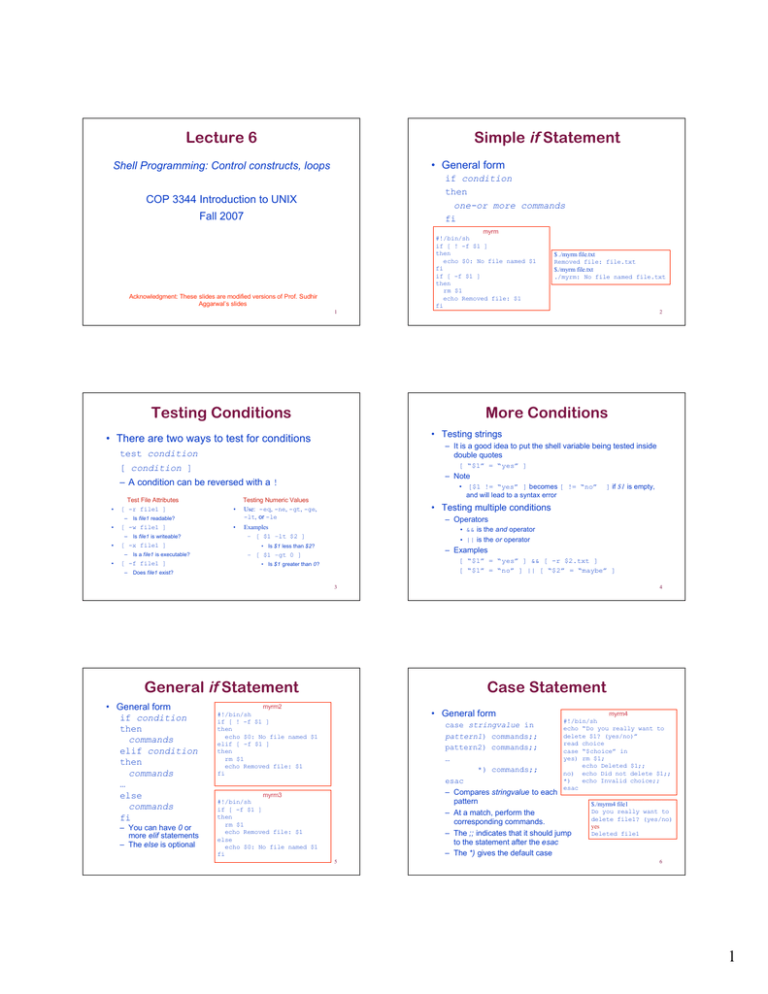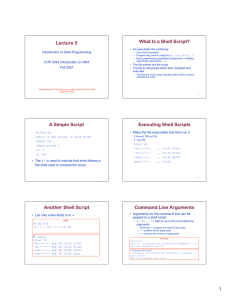if Statement Lecture 6 Simple Shell Programming: Control constructs, loops
advertisement

Simple if Statement Lecture 6 • General form Shell Programming: Control constructs, loops if condition then one-or more commands fi COP 3344 Introduction to UNIX Fall 2007 myrm #!/bin/sh if [ ! -f $1 ] then echo $0: No file named $1 fi if [ -f $1 ] then rm $1 echo Removed file: $1 fi Acknowledgment: These slides are modified versions of Prof. Sudhir Aggarwal’s slides $ ./myrm file.txt Removed file: file.txt $./myrm file.txt ./myrm: No file named file.txt 1 2 Testing Conditions More Conditions • Testing strings • There are two ways to test for conditions – It is a good idea to put the shell variable being tested inside double quotes test condition [ “$1” = “yes” ] [ condition ] – Note – A condition can be reversed with a ! • Test File Attributes [ -r file1 ] – • [ -w file1 ] – Is file1 is writeable? • [ -x file1 ] • [ -f file1 ] – – • Is file1 readable? Is a file1 is executable? • • [$1 != “yes” ] becomes [ != “no” and will lead to a syntax error Testing Numeric Values Use: -eq, -ne, -gt, -ge, -lt, or -le ] if $1 is empty, • Testing multiple conditions – Operators Examples – [ $1 –lt $2 ] • && is the and operator • || is the or operator • Is $1 less than $2? – Examples – [ $1 –gt 0 ] [ “$1” = “yes” ] && [ -r $2.txt ] [ “$1” = “no” ] || [ “$2” = “maybe” ] • Is $1 greater than 0? Does file1 exist? 3 General if Statement • General form if condition then commands elif condition then commands … else commands fi – You can have 0 or more elif statements – The else is optional 4 Case Statement myrm2 • General form #!/bin/sh if [ ! -f $1 ] then echo $0: No file named $1 elif [ -f $1 ] then rm $1 echo Removed file: $1 fi myrm4 #!/bin/sh case stringvalue in echo “Do you really want to delete $1? (yes/no)” pattern1) commands;; read choice pattern2) commands;; case “$choice” in yes) rm $1; … echo Deleted $1;; *) commands;; no) echo Did not delete $1;; *) echo Invalid choice;; esac esac – Compares stringvalue to each pattern $./myrm4 file1 Do you really want to – At a match, perform the delete file1? (yes/no) corresponding commands. yes – The ;; indicates that it should jump Deleted file1 to the statement after the esac – The *) gives the default case myrm3 #!/bin/sh if [ -f $1 ] then rm $1 echo Removed file: $1 else echo $0: No file named $1 fi 5 6 1 for statement • General form while statement backup for variable [ in word_list ] #!/bin/sh for filename do do commands cp $filename $filename.bak done done – The commands are executed several times – Each time, the variable is assigned a different word in the word_list – If in word_list is omitted, then variable is assigned each of the command line arguments backup2 #!/bin/sh list=“myrm2 tests.sh” for filename in $list do cp $filename $filename.bak done • General form while condition do commands $ls myrm2 tests.sh $./backup tests.sh myrm2 $ls myrm2 myrm2.bak tests.sh tests.sh.bak done calc #!/bin/sh read var1 op var2 while [ $var1 != quit ] do echo $var1 "$op" $var2 = `expr $var1 "$op" $var2` read var1 op var2 done ./calc 2+4 2 + 4 = 6 3*5 3 * 5 = 15 4/2 4 / 2 = 2 quit 7 Using exit 8 Example of exit myrm5 #!/bin/sh if [ -f $1 ] then rm $1 exit 0 else exit 1 fi • The exit command makes the shell script terminate – It can set the status at the time of exit • General form exit or exit status – Zero normally indicates success – Nonzero values indicate some type of failure rmfiles #!/bin/sh for filename do if ./myrm5 $filename then echo Removed file: $filename else echo Unable to remove $filename fi done $ ./rmfiles asj ddaas Unable to remove asj Unable to remove ddaas $ ./rmfiles *.bak Removed file: calc.bak Removed file: myrm.bak 9 10 2



